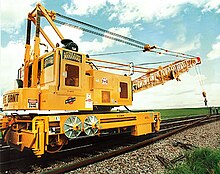



A railway crane (North America: railroad crane, crane car or wrecker; UK: breakdown crane) is a type of crane used on a railway for one of three primary purposes: freight handling in goods yards, permanent way (PW) maintenance, and accident recovery work. Although the design differs according to the type of work, the basic configuration is similar in all cases: a rotating crane body is mounted on a sturdy chassis fitted with flanged wheels. The body supports the jib (UK; North America: boom) and provides all the lifting and operating mechanisms; on larger cranes, an operator's cabin is usually provided. The chassis is fitted with buffing (UK) and/or coupling gear to allow the crane to be moved by a locomotive, although many are also self-propelled to allow limited movement about a work site.
For cranes with a jib that extends beyond the length of the chassis, an idler car (also known as a 'jib carrier' (UK) or 'boom car' (North America)) is provided to protect the jib and to allow the crane to be coupled within a train. The idler car is usually a long, flat wagon (i.e. a flatcar) that provides a means of securing the jib for transportation; storage areas for special equipment or supplies are usually fitted too. It was not uncommon for the idler car to be built on a withdrawn revenue-earning wagon, such as on the Great Western Railway after the Grouping and in the 1930s (where they were referred to as 'match trucks').[1]
- ^ A history of GWR goods wagons. Vol. 2, Wagon types in detail. Newton Abbot: David & Charles. 1976. p. 45. ISBN 0715372904.